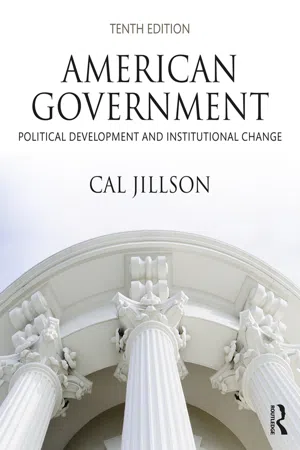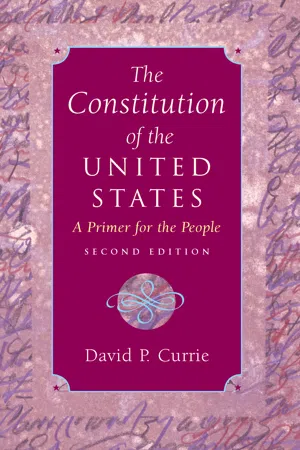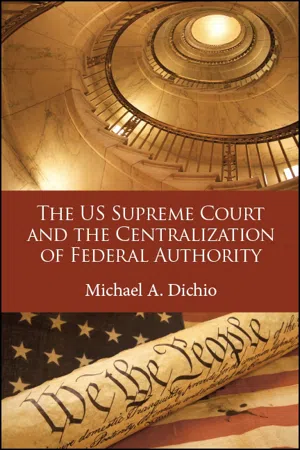Politics & International Relations
United States v. Lopez
"United States v. Lopez" refers to a landmark 1995 Supreme Court case in which the Court struck down the Gun-Free School Zones Act, ruling that it exceeded Congress's power under the Commerce Clause. This decision marked a significant shift in the Court's interpretation of federal power, limiting the scope of congressional authority to regulate activities that do not have a substantial impact on interstate commerce.
Written by Perlego with AI-assistance
Related key terms
3 Key excerpts on "United States v. Lopez"
- eBook - ePub
American Government
Political Development and Institutional Change
- Cal Jillson(Author)
- 2019(Publication Date)
- Routledge(Publisher)
Bill Clinton thought that government had an important role to play in American life, but that many problems were better addressed by people in their states and communities. He sought to redirect both financial resources and programmatic responsibilities to the states. After 1994, President Clinton’s desire to produce a balanced budget joined with the Republican Congress’s desire to shift primary responsibility for social welfare policy in the United States from the national to the state level to produce a dramatic overhaul of federal relations. In key policy areas like welfare, health care, job training, and transportation, Congress and the president rolled dozens of separate grant programs into a few large block grants. Each block grant gave the states greater flexibility in deciding how to spend the money allocated to them. However, the block grants often included only about 70 percent of what the federal government spent on the same programs when it administered them.President George W. Bush accelerated the process of moving financial resources and policy responsibility to the states, especially in the areas of education, health care, homeland security, and electoral reforms. However, like Reagan, Bush also cut taxes, and the resulting budget deficits put new pressure on federal support for the states.25Just as momentously, in a series of narrow 5–4 judicial decisions, beginning with U.S. v. Lopez (1995) and extending through U.S. v. Morrison (2000), the Supreme Court moved to limit the ability of the president and Congress to use the commerce clause to push states in directions that they did not wish to go. In Lopez , the court decided that the national government’s prohibition on guns near schools was too loosely connected to regulating commerce to be justified. Similarly, in Morrison , the court held that the 1994 Violence Against Women Act was unconstitutional because its impact on commerce was too remote to displace the rights of the states to legislate as they see fit in this area. Lopez and Morrison were the first cases in more than 70 years, since Wickard v. Filburn in 1942, in which the court struck down an attempt by Congress to regulate some realm of public activity under the commerce clause.U.S. v. Lopez (1995) The court found that Congress’s desire to forbid carrying handguns near schools was too loosely related to its power to regulate interstate commerce to stand. The police powers of the states cover such matters.U.S. v. Morrison (2000) Citing U.S. v. Lopez , the court found that the Violence Against Women Act was too loosely related to Congress’s power to regulate interstate commerce to stand.However, constitutional interpretation rarely goes in a straight line. In the 2005 case of Gonzales v. Raich, the Supreme Court upheld Congress’s power under the commerce clause to make marijuana possession illegal. The court declared that regulating possession and use of marijuana fell “squarely within Congress’s commerce power.” The court’s conservatives, led by then-Chief Justice Rehnquist, then-Justice O’Connor, and Justice Thomas, were dismayed. Justice Thomas argued that “if Congress can regulate this under the Commerce Clause, then it can regulate virtually anything, and the federal government is no longer one of limited and enumerated powers.”26 - eBook - ePub
The Constitution of the United States
A Primer for the People
- David P. Currie(Author)
- 2010(Publication Date)
- University of Chicago Press(Publisher)
16 Earlier decisions upholding Congress’s power to regulate local transactions, Chief Justice William Rehnquist explained, had dealt with “economic activity”; they did not support a statute making it a federal crime to carry guns in school.Just where the Court’s newfound respect for state rights will lead remains to be seen; two Justices whose votes were necessary to the result wrote separately to emphasize that no departure from earlier decisions was intended. It is refreshing all the same to discover that there are still cases in which the judges will enforce the Constitutions plain principle that not all powers are given to the federal government.THE COMMERCE CLAUSE AND STATE AUTHORITYArticle I, § 8 gives Congress “exclusive” authority to legislate for the District of Columbia. Article I, § 10 expressly excludes the states from certain other areas of congressional competence; no state may coin money, for example, or make treaties. In contrast to these provisions stands the Commerce Clause, which grants Congress authority to regulate interstate and foreign commerce without - eBook - ePub
- Michael A. Dichio(Author)
- 2018(Publication Date)
- SUNY Press(Publisher)
76Other Commerce Clause cases, such as the Shreveport Rate Case (1914)77 and the “stream of commerce” cases, extended federal authority over economic activity. In Shreveport , the Court upheld federal regulation of rates for rail transport between points within a state, reasoning that they bore a “close and substantial” relationship to interstate commerce. The Court similarly approved congressional supervision of “local” transactions in public stockyards because they were located in a “current” or “stream” of interstate commerce.78Individual Rights and Expansive Central State Development
After 1900, the Court’s pattern concerning individual rights looks similar to its pre-1900 decisions: expanded central state authority over citizens for both conservative and liberal aims. With America’s involvement in World War I, free-speech issues and the world systems dimension became ever more paramount, as seen in Schenck v. U.S. (1919) and Abrams v. U.S. (1919), and led to an expansion of central state authority that limited speech rights. In Schenck , the Court upheld Congress’s Espionage Act, which enabled the federal government to suppress Schenck from circulating literature that criticized the military draft.79 Similarly, in Abrams , the defendants were also convicted under the Espionage Act on the basis of two leaflets they printed and distributed that denounced sending American troops to Russia as well as the US war efforts to impede the Russian Revolution.80 The Court upheld the Espionage Act and the defendants’ twenty-year prison sentence.Other free-speech issues also extend central state authority. Gitlow v. New York (1925) incorporated the Free Speech Clause of the First Amendment to the states.81
Index pages curate the most relevant extracts from our library of academic textbooks. They’ve been created using an in-house natural language model (NLM), each adding context and meaning to key research topics.


